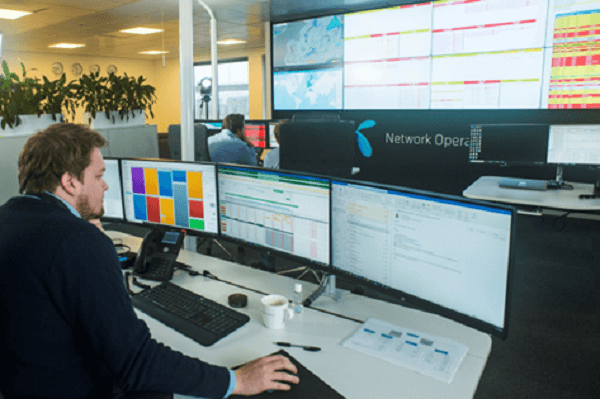The Maritime World Gets More (IoT) Connected
Control your hybrid communication with the Global Data SIM and the on-shore management platform

Our world is becoming more and more connected. Just think about the apps we use on our mobile phones, fitness trackers, wearables and our connected vehicles with dynamic route planning and even remote software updates. In the maritime vertical, IoT is also supporting the digital transformation, operational processes and automated ESG reporting. Digitalisation brings with it exciting possibilities looming on the horizon that will certainly shape the future of operations at sea.
Every day, Telenor is connecting millions of IoT devices in various industry segments. Telenor Maritime enables digitalisation on board vessels with WaveAccess for collecting IoT signals, and Unified Hosting Service on board platform hosting applications and prioritising traffic. This is important since not all IoT data needs to be sent ashore instantly.
In some cases, such as on cruise ships, Telenor Maritime collects 100+ onboard IoT signals which are hosted on shore and published on an insightful dashboard. The stored data may also be reviewed for deeper analytics.
Telenor Maritime Global Data SIM provides connectivity to the IoT data. The Global Data SIM is different from typical, localised IoT SIMs since those sims are often provided for land-based networks (such as NB-IoT etc.), designed for small data packages, whereas the Global Data SIM is designed for large data volumes worldwide near-shore use, where mobile backhauling is a more cost-effective alternative to VSAT. Telenor Maritime’s customers have access to their own SIM Management Platform, where they can see the data usage of their vessels and download monthly reports to invoice their individual vessels when needed. Also, they can set monthly thresholds for their whole fleet to ensure cost management.
Telenor Maritime Global Data SIM can be used in six geographical maritime zones in 140 countries. Via remote access management the SIMs may be deactivated in a specific zone if required, explains Gerrit Jan Konijnenberg, a veteran of global mobile connectivity.
Challenges for the maritime vertical
There are many different SIM types: local pre-paid SIMs, national operator SIMs and the eSIM. Each of these SIMs have their own pros and cons, explains Konijnenberg:
• Pre-paid cards are low cost, but when used for a whole fleet they are difficult and costly to manage. Handling internal invoicing and topping-up the prepaid allowance when consumed can take a lot of time.
• The national operator SIMs are ideal for usage in national waters (like for fishing) and roaming into neighboring countries (like river cruise), but they are less suitable for global shipping, as the national operators often have more costly roaming agreements with countries on the other side of the world. Also, eSim providers come and go. The main advantage of the eSim is that in another country, a local operator may be used which allows local tariffs. These eSims are designed specifically for IoT devices travelling to other countries where they will stay indefinitely (like refrigerator or a vehicle).
• The usage of an eSim for global IoT connectivity is not advised due to the cumulative cost of changing the operator profile all the time. Also, it takes time for the eSim to get another profile when near the shore of another country. This issue creates problems for the connectivity management in the modem since the modem may have already switched back to VSAT while the eSim is updating.
By using a dedicated maritime global data SIM, these challenges are avoided. The Telenor Maritime Global Data SIM provides global connectivity based on our own Telenor Roaming agreements with our own 24/7 NOC and SOC support, explains Konijnenberg.

Complete solution
Konijnenberg has worked with shipowners for more than a decade. No ships are the same: some vessels have many passengers, some have time-critical data, some are sailing globally, some are large and some small, some have VSAT and others don’t. The configuration of both the SIM and the antenna needs attention. It is important to have a robust SIM with global coverage, without down throttling the speed. That is why Telenor Maritime developed the Global Data SIM, a bill-shock free solution where cost is predictable, managed through a user-friendly interface.
According to Konijnenberg, this is important due to the large volume of data sent from ship to shore.
We deliver the Global Data SIM including the remote management platform as a stand-alone solution. However, we can provide the whole infrastructure, which includes the onboard IoT collection device and a hosting platform as well as modems and antennas, which then also includes the services from our Stavanger Maritime NOC.

To sum up: A constantly moving, connected ship will move through both reasonably priced and very expensive networks. This has often been mitigated by using local sims – which is a time-consuming and easily forgotten task, leading to surprises. Telenor Maritime Global Data SIM ensures predictable pricing along the coastline of more than 140 countries - divided across 6 maritime zone, plus the Telenor Maritime coverage on the Nordic Continental Shelf.
So, just like you drive your connected vehicle across a national border, a captain/fleet manager or IT department can now navigate vessel connectivity across global countries coastlines without worrying. The Global Data SIM will take care of it!

that matters most
Get the latest maritime news delivered to your inbox daily.
For additional information contact Gerrit Jan Konijnenberg, Director Strategic and Commercial Development, Telenor Maritime.
This article is sponsored by Telenor Maritime.
The opinions expressed herein are the author's and not necessarily those of The Maritime Executive.
